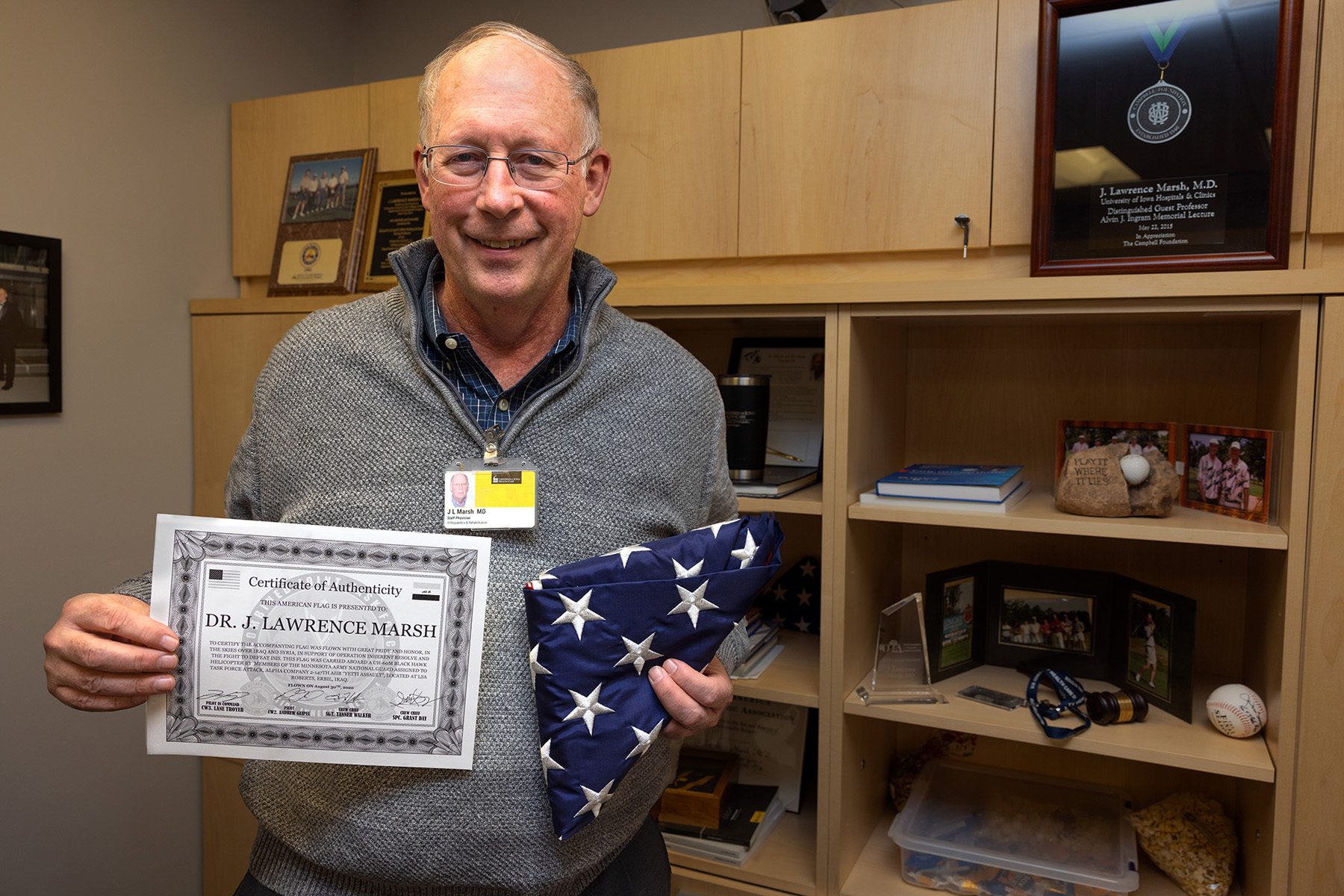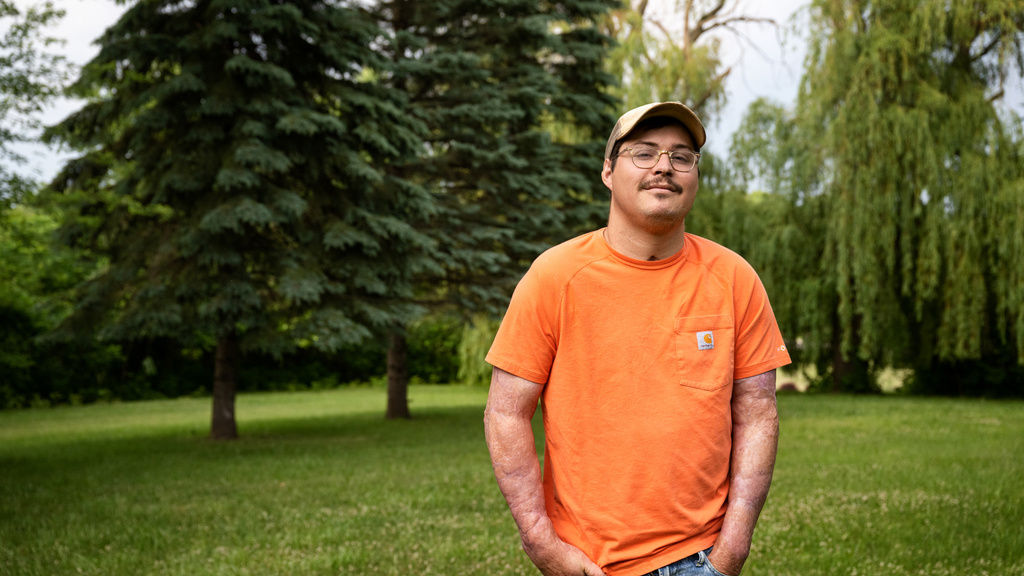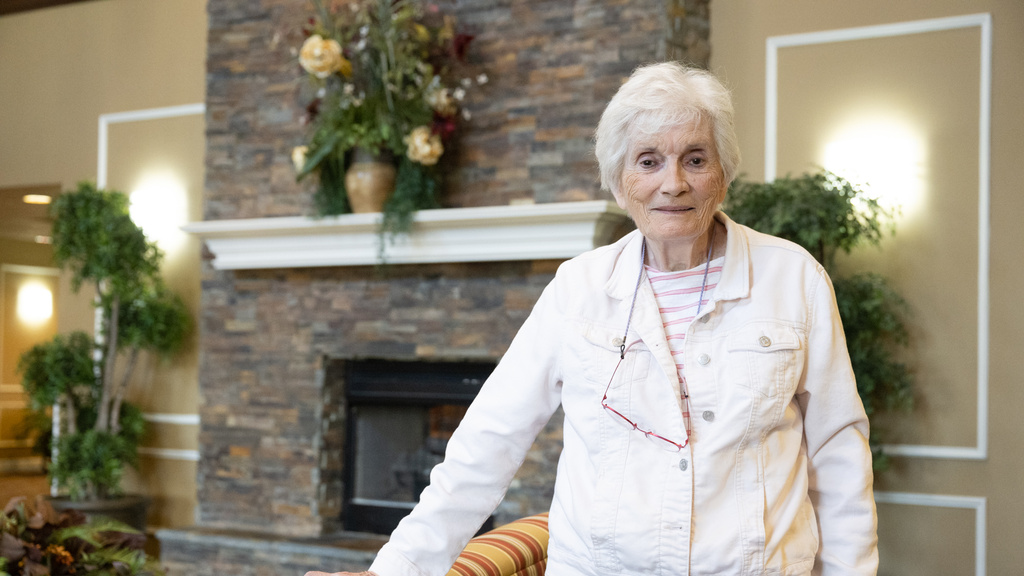Grant Day credits the care he received at University of Iowa Health Care Medical Center after a snowmobile accident with being able to later join the National Guard and become a firefighter.
Story: Emily Nelson
Photography: Justin Torner and Jesse Wallace
Published: Jan. 31, 2022
While deployed to Iraq, Sgt. Grant Day, a Black Hawk helicopter door gunner and mechanic for the Iowa Army National Guard, flew a flag he had hanging in his quarters on a Black Hawk during a mission.
When Day returned home, he presented the flag and a certificate signed by the Black Hawk crew to J. Lawrence Marsh, MD, an orthopedic surgeon at University of Iowa Health Care Medical Center.
“Because of Dr. Marsh, I was able to join the Iowa Army National Guard, where I continue to serve, and become a volunteer firefighter for Green Mountain Fire and EMS,” Day says. “Without Dr. Marsh, I would not have been able to have the privilege of serving my country, state, and community for the last 10 years and many more years to come.”
Day was 13 years old in January 2008 when the snowmobile he was riding hit something under the snow and he was thrown almost 50 feet. He couldn’t feel his left arm but was able to pull out his cellphone and call his parents, who raced out to find him. Meanwhile, a man driving by saw Day lying in the field and stopped. When first responders got there, the ambulance was unable to get to Day, so his father drove his truck into the field and Day was loaded onto a stretcher and into the back of the truck.
Day was taken to the emergency room in Marshalltown, Iowa, where he was found to have multiple fractures, including an open fracture that had broken through the skin, and a shattered growth plate in his left arm. The local hospital said it didn’t have the expertise to treat Day and began calling hospitals in and around the state. No one was comfortable treating Day’s injuries — until they spoke with UI Health Care Medical Center.
“Several local doctors had told me I would only have 70% mobility in my arm if I was lucky, on top of the possibility that my arm may not grow anymore,” Day says. “After being prepped for surgery, Dr. Marsh entered the OR, introduced himself, and told me he was confident that I would have full use of my arm.”
Orthopedic Trauma and Fractures Clinic
The University of Iowa Orthopedic Trauma and Fractures Clinic serves patients who have been injured in a traumatic event, such as an accident while driving or working. As part of the only nationally ranked orthopedics program in Iowa, the clinic is committed to providing personalized orthopedic care aimed at relieving pain and helping people return to a normal life.

J. Lawrence Marsh, MD, an orthopedic surgeon at University of Iowa Hospitals & Clinics, holds a U.S. flag and a certificate that were presented to him by Sgt. Grant Day, a Black Hawk helicopter door gunner and mechanic for the Iowa Army National Guard. While deployed to Iraq, Day flew this flag on a Black Hawk during a mission, and presented it to Marsh as a token of gratitude for treating the arm injuries Day suffered as a child.
Surgery included the placement of pins, rods, and plates, of which the plates remain in place to this day.
Marsh says there has been a shift over the years in caring for children with broken limbs, even those with breaks less serious than Day’s.
“These breaks can have growth implications for children,” Marsh says. “Local hospitals, while they may treat an adult with a break, as soon as a child falls off a swing set and has a displaced distal humerus fracture, they’ll send them to us.”
Fourteen years later and a foot taller than he was in 2008, Day says his left arm works better than his right.
A few years after the accident, doctors at the UI confirmed with the Iowa Army National Guard that Day’s injuries were completely healed and would not be an impediment to his service. Since then, Day has been deployed twice to Iraq, where he’s flown missions into Kuwait, Syria, and Jordan, including one with the flag he presented to Marsh.
“Because of Dr. Marsh, I was able to join the Iowa Army National Guard, where I continue to serve, and become a volunteer firefighter for Green Mountain Fire and EMS. Without Dr. Marsh, I would not have been able to have the privilege of serving my country, state, and community for the last 10 years and many more years to come.”
Marsh says he is honored that Day thought of him.
“It’s amazing to think that we were able to have such an effect on a young person’s life over a relatively brief period of time and that they carried that gratitude with them growing up and then while serving our country,” Marsh says.
Day’s accident wasn’t the last time his family encountered Marsh. The orthopedic surgeon also performed two knee replacements on Day’s grandmother. Day accompanied her to an appointment and reminded Marsh who he was.
“He didn’t remember at first but he looked up my record and remembered my X-rays,” Day says.
Marsh says Day’s injuries were very bad but typical of others that he and his colleagues care for. With these types of injuries there are certainly risks and things that can go wrong.
“But there was a reasonable expectation of a good result, and he had a good result,” Marsh says. “And he carried his remembrance of his good result all these years and into his future, and, you know, that’s a credit to him more than us. But it’s also a credit to how orthopedic care that goes well can have a long-lasting impact on people’s lives. And that’s exactly what we try to achieve.”



